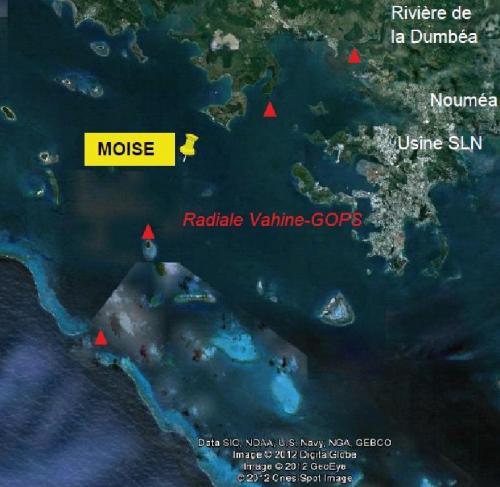New Caledonia
Type of resources
Available actions
Topics
INSPIRE themes
Keywords
Contact for the resource
Provided by
Formats
Representation types
Update frequencies
status
Scale
-

Le projet interdisciplinaire UECOCOT vise à développer des outils d'aide à la gestion durable des activités minières afin de permettre la meilleure cohabitation possible entre dynamique naturelle des environnements (et leur capacité de résistance aux dommages et de résilience) et les activités humaines (industrielles ou non). L'objectif global du projet est de répondre à la question " comment adapter , à un coût socio-économique acceptable, les activités minières pour que leur impact reste compatible avec la durabilité des écosystèmes côtiers et littoraux". Pour atteindre un tel objectif, le projet UECOCOT repose sur une approche multi-sites ayant des impacts miniers différents. Dans le Pacifique sud, le site choisi est le lagon de Koné (Nouvelle-Calédonie) à proximité duquel s'est implanté une mine de nickel et touché par des apports de particules riches en éléments métalliques (Ni, Cr, Co, Mn) issues de l'altération des massifs miniers latéritiques développés sur des péridotites. C'est dans ce cadre qu'a eu lieu en février 2018 une campagnes océanographique multidisciplinaire dans le lagon de Koné dont l'objectif était d'acquérir des informations sur : i) les flux hydrodynamiques et biogéochimiques entre la côte, le lagon et l'océan et les connectivités au sein même du lagon, ii) l'état écologique du lagon et son fonctionnement End to End (hydro-bio-géochimique) , iii) les apports miniers directs ou indirects (avec un focus sur les métaux) et leur impact sur le fonctionnement biogéochimique. L'ensemble des résultats acquis doit permettre de valider un modèle numérique de biologie intégrant les aspects physiologiques et comportementaux des organismes (plancton et benthos) liés à la contamination du milieu et à la circulation hydrodynamique au sein du lagon. Il doit en particulier aboutir à une meilleure compréhension du rôle de la barrière récifale sur la régulation hydrodynamique et ainsi permettre d'affiner les prévisions en terme de contamination du lagon suite à une modification de la structure récifale sous l'effet conjugué de contraintes anthropiques et climatiques. Ce projet s'inscrit dans le réseau international AMEDEE (Activité Minière, Environnement, Développement Economique, Ethiques) qui regroupe les programmes de R&D de 40 institutions scientifiques (Colin, 2016)
-

The New Caledonia lagoons show high seasonal and interannual variability (related to El Niño – Southern oscillation – ENSO - variability). They present a great diversity of local situations linked to differences in their geomorphology, to the nature of terrigenous inputs and to varied anthropogenic pressure. This variability impacts the structure of planktonic communities and their biodiversity. The scientific objectives of the CLAPPP project developed on 6 New Caledonia lagoons are : - 1) to describe the local environmental conditions and their seasonality, - 2) to understand the heterogeneity of phytoplankton communities at the biological, spatial and/or temporal levels, - 3) to study the role of this diversity in the functioning of coral ecosystems and the regulation of biogeochemical cycles, and - 4) to assess the importance of phytoplankton as an index of productivity and health of the lagoons in relation with local stress conditions and the risk of HABs. DOI: - https://doi.org/10.34930/2b52defe-e5f3-4fe2-9f2f-741d90e624ea Citation: Rodier, M., & Arfi, R. (2020). CLAPPP - New Caledonian lagoons: Physics and Phytoplankton processes [Data set]. MIO UMR 7294 CNRS. https://doi.org/10.34930/2B52DEFE-E5F3-4FE2-9F2F-741D90E624EA
-

The MOISE project is part of a medium- and long-term approach to monitoring the coastal environment in New Caledonia. Initiated at the end of 2011, this monitoring is based on the installation of a fixed mooring with automatic physico-chemical, optical and biological measurement systems. This approach makes it possible to address the different scales of temporal variability characteristic of the dynamics and functioning of the lagoon ecosystem, including the daily scale. Since 2012, this high-frequency in situ monitoring has been supplemented by monthly monitoring with discrete measurements and vertical profiles over the entire water column; the parameters measured and the methods used are modelled on those of the SOMLIT network, with a view to MOISE's accreditation as an observation station. Medium and long term observation of the coastal environment in New Caledonia. Climatic variability in tropical zones. Evolution of the monthly, seasonal and interannual variability of the hydrological and biogeochemical characteristics of marine waters at a point located off the Bay of Dumbéa (N-NW of Noumea, New Caledonia) on a depth of 10m. Measurement of the impact of natural and anthropogenic forcings on the environment, study/quantification of the consequences of this variability, both natural and anthropogenic, on the structuring and functioning of the pelagic ecosystem, and in particular on the appearance of diazotrophic blooms. Validation of the images obtained by different ocean color sensors by monitoring the variations of the "water color" for an adjustment of the algorithms of calculation of the chlorophyll obtained from satellite reflectance. Possible measurements of the impact of the atmospheric plume of the SLN (Société Le Nickel = nickel treatment by pyrometallurgy) following preliminary work.
 OSU Pytheas - Data Catalog
OSU Pytheas - Data Catalog